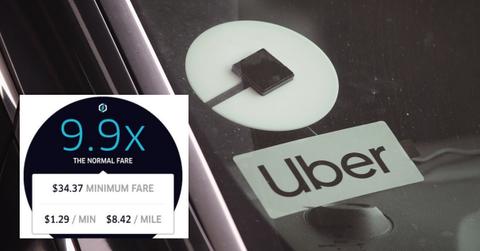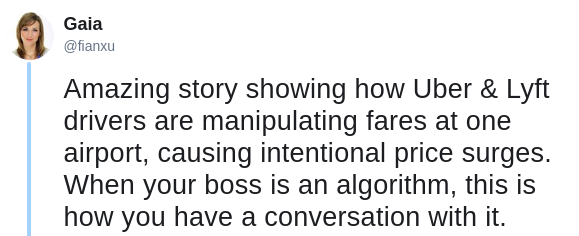Uber and Lyft Drivers Are "Hacking" Surge Prices: Here's How They Do It
Updated June 14 2019, 10:04 a.m. ET

If you ever cracked open your Uber app and felt like there was some grand surge-pricing conspiracy going on, you may be right.
It's always frustrating when you're about to catch a ride that usually costs $10 and then when you whip out your phone you're hit with a crazy $50 price hike that seemingly came out of nowhere. This is especially true when it happens at a time that's normally "quiet."
And by "quiet" I mean that there aren't a lot of people requesting Uber/Lyft fares, so the app's algorithm adjusts the prices to be a bit more competitive to match demand. A huge factor that plays into this algorithm are the number of drivers that are available to cart people to and from their jobs, social gatherings, airports, Miami Vice-themed birthday parties, etc.
You may have always had a suspicion that something "fishy" was going on with these out-of-the-blue surge pricings, and as it turns out, not all of them are coincidental. WJLA, a local ABC 7 news station reported on "artificial surge prices" at Reagan National Airport and discovered that Uber and Lyft drivers were all hacking their apps in order to drive up passenger fares.

When the news station reached out to Uber for a comment, the company responded by saying it was an "isolated incident" and that they had "safeguards" to ensure that other drivers weren't using the same hack.
But after the station's story went viral, tons of other drivers came forward and confirmed that they have been engaging in the hack and Uber/Lyft really haven't been able to do anything about it.
How do Uber drivers "hack" surge prices?
Different drivers employed by rideshare companies confirmed in videos that they were part of a "Surge Club" of sorts, which is a group of drivers who work together in order to "hack" the algorithm and give every single one of them a surge pricing boost. Dustin, from Tampa, Florida, talked about the phenomenon:

"...rule number one, we don't talk about ‘Surge Club.' Come on now. If you're doing something you shouldn't be doing, you don't go tell the world about it. Yes, people have been doing this for a long, long time."
So how does the hack work? It involves a dedicate group of drivers who all communicate with one another, which is as easy as creating a WhatsApp group.
Then they decide on a time to "flip the switch off." When each driver goes offline for a minute or so, prices in the app begin to skyrocket, after they go back online, it takes a while for the algorithm to reset and each driver enjoys a nice surge boost while customers are forced to pay more for a ride than they're "supposed" to given the amount of available drivers.

The drivers who submitted videos to ABC7 demonstrated that they were able to make $10 or $20 more per ride with this method and after a long day/night of picking up fares that can really add up. Naturally, there are a bunch of drivers who are upset that folks are "spilling the beans" but many who came forward are saying that they feel they've been given no other option.
With fare-cuts dropping the pricing of some rides to $5 or $6 after expenses, drivers are left frustrated. I did Lyft myself a couple of summers ago to make some extra cash. And while some weeks left me with a decent amount of cash, others were absolutely horrible. I would actually spend more money in gas, tolls, and car maintenance than I earned from the app itself — that's how little I made off of each ride.

The reason why this "surge-pricing" hack works in a place like an airport is because it's hard to determine when the surges are real or artificial. Everyone who's ever tried using a rideshare app at an airport knows it can be a free-for-all, people are coming and going constantly and there very well could be a dearth of drivers instead of a scheming group of people trying to make some extra cash.
Uber maintained that they are able to ascertain when surge hacking takes place and ensures that drivers who are caught engaging in it will be banned from the app.
Have you ever encountered unexpected surge pricing? What were the circumstances behind it?